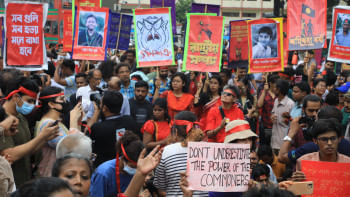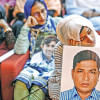Aynaghar should be a site of remembrance

Completing a tour at the ESMA Museum and Site of Memory, located on the grounds of what was once the officers' quarters of the Navy School of Mechanics (ESMA), in the city of Buenos Aires, Argentina, takes around 90 minutes. The museum, which was a former clandestine centre of detention, torture, and extermination, features 17 rooms hosting traditional and contemporary museographic exhibits centred around survivor testimonies, historical documents from the National Commission on the Disappearance of People, the Trial of the Military Junta, declassified state documents, among other archives.
During the military dictatorship in Argentina from 1976 to 1983, the officers' quarters at ESMA became a key site for suppressing the opposition as part of a national strategy. Thousands of people, both armed and peaceful, were abducted in Buenos Aires, brought to ESMA, and subjected to interrogation, torture, and often death. Some 5,000 of the approximately 30,000 people who disappeared at the hands of the military junta during those years passed through ESMA, making it the largest torture centre of that era.
After the crimes committed on the site became known, and after years of uncertainty about its future, the recovery process to transform the ESMA premises into a Space for Memory and for the Promotion and Defense of Human Rights began in 2004. On May 19, 2015, after years of debates and consensus reaching, the ESMA Museum and Site of Memory was inaugurated. In September 2023, UNESCO recognised it as a World Heritage Site, a site of "outstanding universal value" that belongs to the common heritage of humanity.
According to UNESCO, the building has been protected as judicial evidence since 1998 owing to the crimes against humanity committed there during its operations as a clandestine detention and extermination centre. From then on, any kind of modification was prohibited. In the present day, all efforts to conserve and restore the building are guided by scientific studies, aimed at preserving it both as a piece of legal evidence and as a valuable historical record. That's why all kinds of markings and inscriptions, denoting the stay of the detained-disappeared at the place, are preserved. These include different types of inscriptions on the walls, as well as on both the iron and wooden structures in the building. There are markings that were made with unidentified sharp objects, and others with ink or graphite: names, phone numbers, initials, inscriptions of party affiliations, dates, drawings.
That is why it is very important to preserve the secret detention centres in Bangladesh, popularly known as "Aynaghar," used for enforced disappearances during the Hasina regime due to its huge historical, heritage, and judicial value as evidence in carrying out crimes against humanity. In Argentina, evidence dating back more than 40 years remains intact, but in Bangladesh, within two months of the fall of the Hasina regime, many kinds of evidence of enforced disappearances have been destroyed.
The Commission of Inquiry on Enforced Disappearances, which was formed to investigate cases of enforced disappearances during the past Awami League government, has found evidence of destroyed materials at the secret detention centre run by the Directorate General of Forces Intelligence (DGFI). Messages, names, phone numbers, and addresses written on the walls of the detention centre by the victims were erased by painting over the walls. Not only that, Law Enforcement Agencies (LEA) want to destroy the secret prisons to protect their image on an international level. Furthermore, according to a report by the daily Samakal, work is underway to demolish the cells inside the DGFI-run detention centre and change the interior of the one-story building.
But keeping Bangladesh's secret detention centres intact, like Argentina's, is important for both legal and historical reasons. Allowing the demolition or alteration of Aynaghar in the name of protecting the international image of LEAs would on the one hand destroy important evidence for the trial and on the other hand create an opportunity to deny historical truth in the future.
According to the Asian Human Rights Commission (AHRC), at least 623 people were victims of enforced disappearance in the country from 2009 to 2022. Of those, 84 bodies were recovered, 383 were either returned alive or shown arrested later. Still missing are 153 people, and there is no information about three others.
Within two days of Hasina's government being overthrown in a mass uprising, several of the missing persons have returned from the secret detention centres, but many are still missing; many others do not know what happened to their relatives. The aforementioned commission had received nearly 400 complaints of forced disappearances within two weeks of starting their work. There are also many questions about who were involved in the disappearance. Even in the cases where people have returned alive, it is not clear who detained them and where.
The LEAs that were involved in enforced disappearances during the Hasina regime are still the same with no fundamental changes. The LEAs have not acknowledged the responsibility, nor revealed who were involved in the enforced disappearances. Rather, they seem to be actively destroying the evidence of enforced disappearances.
Not only as legal evidence, but to ensure that the forced disappearances do not happen again in the future, it is important to keep the history of Aynaghar alive and intact. As the then Argentine president Alberto Fernández explained, "Collective memory is what keeps people from repeating their histories and allows them to move forward towards a better future."
That's why, not only Argentina, but many other countries around the world which had suffered from enforced disappearance or state terrorism, have taken various steps to preserve the memories. For example, Villa Grimaldi, an old villa on the edge of Chile's capital city of Santiago, which was used as a major torture centre from 1974-78 during the rule of General Pinochet, has been converted as a sitios de memoria or memory sites in 1995, to remember those who had suffered and died under the military's rule. About 5,000 prisoners passed through Villa Grimaldi, and it is known that 240 of them were killed or disappeared.
Answers to many questions related to disappearances in Bangladesh are still unknown, including who were involved in the enforced disappearance of how many people, what happened to the persons who are still missing, who were the masterminds of the enforced disappearance, what were the command structures and motivations, etc. In order to know the answers to these questions, bring the perpetrators under justice, and prevent the recurrence of enforced disappearances in future, it is utmost important to preserve all types of evidence related to enforced disappearance. I hope the interim government will take appropriate steps in this regard before it is too late.
Kallol Mustafa is an engineer and writer who focuses on power, energy, environment and development economics. He can be reached at [email protected].
Views expressed in this article are the author's own.
Follow The Daily Star Opinion on Facebook for the latest opinions, commentaries and analyses by experts and professionals. To contribute your article or letter to The Daily Star Opinion, see our guidelines for submission.

 For all latest news, follow The Daily Star's Google News channel.
For all latest news, follow The Daily Star's Google News channel. 











Comments